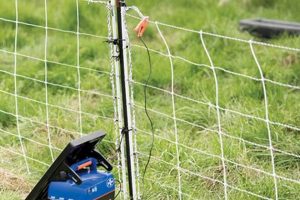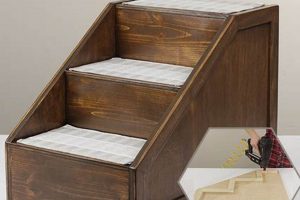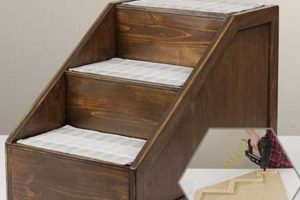A homemade abdominal wrap designed for diminutive canines addresses specific needs related to marking, incontinence, or post-operative care. These custom-made garments provide support and prevent unwanted urination inside the home. For example, a dog recovering from surgery might benefit from the gentle compression a self-constructed band offers.
The utilization of such a device can significantly improve hygiene and sanitation within a household. It also helps maintain a dog’s comfort and dignity by minimizing accidents. Historically, owners have adapted various materials to create makeshift solutions, reflecting a longstanding concern for their pets’ well-being and a desire to avoid commercially available alternatives.
Understanding the construction and appropriate usage of these canine accessories involves considering fabric selection, fastening methods, and proper fitting. The following sections will detail essential considerations for designing and implementing a suitable solution, ensuring both functionality and the animal’s comfort.
Guidance for Crafting Canine Abdominal Wraps
The creation of a suitable abdominal wrap for a small dog necessitates careful consideration of several factors to ensure its effectiveness and the animal’s comfort.
Tip 1: Fabric Selection: Opt for breathable, absorbent materials like cotton flannel or fleece. Avoid synthetics that may cause irritation or trap moisture, potentially leading to skin issues.
Tip 2: Precise Measurement: Accurate measurements around the dog’s abdomen are critical. The band should fit snugly without restricting movement or hindering breathing. A tape measure should be used to determine the precise circumference.
Tip 3: Fastening Mechanism: Hook-and-loop closures, often referred to as Velcro, offer adjustability and secure fastening. Ensure that the hook side is positioned to avoid rubbing against the dog’s skin.
Tip 4: Absorbent Layer: An inner layer of absorbent material, such as reusable diaper inserts or layers of cotton batting, enhances the band’s functionality. This layer should be easily replaceable or washable.
Tip 5: Secure Positioning: The wrap should be positioned correctly, covering the relevant area without impeding leg movement. Consider the dog’s anatomy and adjust the band accordingly.
Tip 6: Washable Components: Ensure the materials used are machine washable to maintain hygiene and extend the lifespan of the wrap. Use mild, unscented detergents to avoid irritating the dog’s skin.
Tip 7: Gradual Introduction: Introduce the wrap gradually to allow the dog to acclimate. Positive reinforcement, such as treats and praise, can help the dog associate the wrap with a positive experience.
Adhering to these guidelines will contribute to a well-fitted and functional device that effectively addresses the specific needs of the animal while prioritizing comfort and hygiene.
The subsequent section will address potential challenges and solutions in the implementation of these techniques.
1. Appropriate Material
The selection of appropriate material directly influences the efficacy and comfort of a self-constructed abdominal wrap for a small canine. Inappropriate material choices can lead to skin irritation, reduced absorbency, and premature wear. For instance, using non-breathable synthetic fabrics may trap moisture, fostering bacterial growth and potentially causing dermatitis. The causal link between material selection and the animal’s well-being necessitates careful consideration of fabric properties.
The importance of appropriate material extends beyond mere comfort. A well-chosen fabric, such as cotton flannel or a bamboo blend, provides adequate absorbency to manage incontinence or marking. Furthermore, durable materials, like tightly woven cotton twill for the outer layer, withstand repeated washing and maintain the band’s structural integrity over time. The practical significance lies in the band’s ability to perform its intended function effectively and reliably.
Ultimately, the suitability of the material is a critical determinant of the device’s overall success. Challenges may arise in balancing cost-effectiveness with quality and durability. However, prioritizing pet-safe, washable, and absorbent materials is essential for creating a functional and comfortable solution, thus linking back to the broader goal of promoting canine hygiene and well-being through the utilization of a self-made device.
2. Accurate Sizing
Accurate sizing represents a foundational element in the creation of a functional and comfortable abdominal wrap. A poorly sized device, whether too tight or too loose, negates the intended benefits and potentially introduces adverse effects. A band that is excessively restrictive can impede circulation, causing discomfort and potentially leading to skin irritation or pressure sores. Conversely, a band that is too loose fails to provide adequate support or containment, rendering it ineffective for managing incontinence or marking behaviors. The cause-and-effect relationship between sizing and functionality underscores the importance of precise measurements.
The practical significance of accurate sizing manifests in the device’s ability to stay in place and perform its intended purpose without causing distress. For example, a small dog with a 14-inch waist requires a band that closely matches those dimensions, allowing for slight adjustability but preventing slippage during activity. In cases of post-operative care, a properly sized band can provide gentle compression, promoting healing while minimizing the risk of wound disruption. Deviations from accurate sizing can negate these benefits, leading to frustration for the owner and discomfort for the animal. Moreover, an ill-fitting band may require constant readjustment, consuming the owner’s time and attention.
Challenges in achieving accurate sizing include accounting for variations in body shape among different breeds and the potential for measurement errors. However, employing a flexible measuring tape and taking multiple measurements can mitigate these challenges. Ultimately, prioritizing accurate sizing is crucial to ensure the effectiveness, comfort, and overall success of the abdominal wrap, linking back to the overarching goal of providing a humane and functional solution for specific canine needs.
3. Secure Fastening
Secure fastening represents a critical design element in the context of homemade abdominal wraps for small canines. It directly impacts the garment’s ability to remain in place and perform its intended function, influencing both the effectiveness of the device and the comfort of the animal.
- Adjustability and Fit
The fastening mechanism should allow for adjustability to accommodate variations in canine anatomy and ensure a snug yet comfortable fit. Hook-and-loop closures (e.g., Velcro) offer a range of adjustability. Poorly adjustable systems may lead to discomfort or inadequate retention. Examples include elastic straps with buckles or snap closures, which can provide a more customized fit, particularly for dogs with unique body shapes.
- Durability Under Stress
The fastening must withstand the physical activity of the dog without failing. Weak or poorly constructed closures can detach, rendering the band ineffective. Reinforced stitching and high-quality materials enhance durability. For instance, industrial-strength hook-and-loop material, combined with double-stitched seams, provides a more robust closure system capable of withstanding the rigors of daily wear.
- Safety and Avoidance of Irritation
The fastening system must not pose a risk of injury or irritation to the dog’s skin. Exposed edges, sharp components, or materials that cause chafing should be avoided. Soft, rounded edges and placement away from sensitive areas are important considerations. For example, a fabric flap covering the hook side of a hook-and-loop closure can prevent direct contact with the dog’s skin, reducing the risk of irritation.
- Ease of Use for the Owner
The fastening should be easy for the owner to apply and remove, even with a potentially uncooperative dog. Complex or cumbersome systems can lead to frustration and inconsistent use. Simple, intuitive designs, such as wide straps or readily accessible closures, improve ease of use. A system that requires minimal dexterity and can be operated with one hand can be particularly beneficial for owners with limited mobility.
The interplay of adjustability, durability, safety, and ease of use in secure fastening mechanisms directly contributes to the overall success of a self-fabricated abdominal wrap for small dogs. These factors ensure the device remains functional and comfortable, addressing the specific needs of the animal without compromising its well-being.
4. Absorbent Core
The absorbent core constitutes a critical functional element within a self-constructed abdominal wrap for small canines. Its primary purpose is to manage urinary incontinence or marking behaviors, preventing soiling of the environment and maintaining hygiene. The effectiveness of this core directly influences the overall utility of the device. Without adequate absorbency, the wrap fails to contain urine, negating its intended purpose and potentially causing skin irritation. The causal link between the core’s capacity and the band’s efficacy is undeniable. For example, a core consisting of thin cotton layers might prove insufficient for a dog with significant incontinence, necessitating frequent changes or rendering the band ineffective. Conversely, a core composed of multiple layers of microfiber or a specialized absorbent fabric, such as those found in reusable diapers, can effectively manage a greater volume of liquid.
The practical significance of understanding the absorbent core extends to material selection and design considerations. Owners must consider the dog’s specific needs and the anticipated volume of urine when choosing materials. Reusable options, such as washable inserts made from bamboo or hemp, offer both environmental and economic benefits. The design should facilitate easy replacement or washing of the core to maintain hygiene and prevent odor. For instance, a pocket sewn into the inner layer of the wrap allows for convenient insertion and removal of absorbent pads. In contrast, a permanently affixed core requires washing the entire band more frequently, potentially reducing its lifespan. Post-operative use of a abdominal wrap might require an absorbent core to contain leakage from the surgical site, demanding a core with enhanced fluid retention.
In summary, the absorbent core’s performance is paramount to the success of a homemade canine abdominal wrap. Challenges may arise in balancing absorbency with comfort and breathability. However, prioritizing high-quality, absorbent materials and a design that facilitates easy maintenance is crucial for creating a functional and hygienic solution. This focus on the absorbent core contributes to the overall goal of improving the dog’s hygiene and well-being while minimizing the environmental impact and cost associated with disposable alternatives.
5. Comfortable Fit
A comfortable fit represents a crucial determinant of a canine abdominal wrap’s success, directly impacting the animal’s acceptance and tolerance of the device. A poorly fitting wrap, regardless of its functional design, will likely be rejected by the dog, rendering it useless. The correlation between comfort and compliance is undeniable; a tight wrap restricts movement, causing chafing and discomfort, while a loose wrap fails to provide adequate support and may slip out of place. For instance, a wrap constructed from rough material or featuring exposed seams can cause skin irritation, leading to the dog scratching and attempting to remove the device. In contrast, a wrap made from soft, breathable fabric and meticulously sized to conform to the dog’s anatomy promotes comfort and reduces the likelihood of rejection. The practical significance of this consideration lies in the long-term usability of the wrap.
The creation of a comfortable fit necessitates careful attention to measurement, material selection, and design. Accurate measurements around the dog’s abdomen, accounting for breed-specific variations in body shape, are essential for determining the appropriate size. The choice of fabric should prioritize softness, breathability, and hypoallergenic properties to minimize the risk of skin irritation. Design considerations include the placement of fasteners to avoid pressure points and the inclusion of elastic panels to allow for flexibility and movement. For example, strategically placed elastic gussets can accommodate the dog’s rib cage and hips, preventing constriction during sitting or lying down. Additionally, ensuring the closure mechanism, such as hook-and-loop fasteners, does not directly contact the dog’s skin helps prevent chafing. Post-operative wraps require even greater attention to comfort, preventing interference with healing incisions.
In summary, achieving a comfortable fit is paramount to the overall success of a self-made abdominal wrap. While challenges may arise in balancing comfort with functionality and durability, prioritizing the dog’s well-being is essential. The ability to create a wrap that is both functional and comfortable ensures long-term compliance, maximizing its effectiveness in addressing specific canine needs. This focus on comfort not only improves the dog’s quality of life but also reinforces the bond between owner and pet, as the animal associates the wrap with positive experiences rather than discomfort or restriction.
6. Easy Cleaning
The practicality of a canine abdominal wrap hinges significantly on the ease with which it can be cleaned. Given the nature of its intended use, frequent cleaning is essential for maintaining hygiene and preventing the accumulation of bacteria and odors. Therefore, the design and materials employed in a self-constructed abdominal wrap must prioritize ease of cleaning to ensure its long-term usability and the animal’s well-being.
- Material Selection for Washability
The choice of fabric directly influences the ease of cleaning. Durable, machine-washable materials like cotton, fleece, or specialized moisture-wicking fabrics are preferable. Materials that are prone to shrinking, fading, or retaining odors should be avoided. For example, a wrap made of tightly woven cotton can withstand frequent washing without significant degradation, while a wrap made of loosely woven fabric may quickly fray or lose its shape. Selecting stain-resistant materials further simplifies the cleaning process. The implications of poor material selection include increased labor in stain removal and a reduced lifespan of the wrap, making material choice a cornerstone of cleaning efficacy.
- Design for Accessibility
The design should facilitate easy access to all areas of the wrap for thorough cleaning. Complex designs with multiple layers or tightly sewn seams can make it difficult to remove trapped debris or residue. A simple, streamlined design with minimal embellishments promotes more effective cleaning. An example is a wrap with a removable absorbent core, allowing for separate washing of the core and the outer shell. A design that allows the wrap to be laid flat for cleaning, rather than remaining bunched up, also improves accessibility. Implications of poor design include incomplete cleaning, leading to odor retention and potential bacterial growth, thereby impacting the animal’s hygiene.
- Fastening Considerations for Cleaning
The fastening mechanism should be durable enough to withstand repeated washing cycles without losing its functionality. Hook-and-loop closures, while convenient, can accumulate lint and debris, reducing their effectiveness over time. Alternatives such as snaps or adjustable buckles may offer greater durability. For instance, high-quality hook-and-loop fasteners, designed for repeated use, can maintain their grip even after numerous washings. Alternatively, snaps made of rust-resistant metal can provide a secure and easily cleaned closure. The implications of a poorly chosen fastening system include the need for frequent replacement or repair, adding to the overall maintenance burden.
- Drying Efficiency
The ability of the wrap to dry quickly is an important factor in maintaining hygiene. Slow-drying materials can remain damp, creating a breeding ground for bacteria and leading to unpleasant odors. Breathable fabrics that air dry quickly, or materials that can be safely tumble-dried, are preferable. For example, a wrap made of fleece may dry relatively quickly, while a wrap made of a thick, non-breathable fabric may take significantly longer. The implications of slow drying include the potential for bacterial growth, odor retention, and an increased risk of skin irritation for the dog. Prioritizing materials that promote efficient drying is therefore essential for maintaining hygiene.
The facets discussed highlight the interconnectedness of material selection, design, fastening considerations, and drying efficiency in ensuring ease of cleaning. The creation of a canine abdominal wrap that is easily cleaned relies on a holistic approach to design and material selection, ultimately contributing to its long-term practicality and the animal’s overall well-being. By carefully considering these factors, owners can create a device that is both functional and hygienic, minimizing the burden of maintenance and maximizing its effectiveness in managing specific canine needs.
7. Durability
The longevity and effectiveness of a homemade abdominal wrap for a small canine are intrinsically linked to its durability. Durability, in this context, encompasses the wrap’s ability to withstand repeated use, washing cycles, and the general wear and tear associated with an active animal. A lack of durability negates the initial benefits of creating a customized solution, as frequent repairs or replacements become necessary. For example, a band constructed with flimsy stitching and easily torn fabric may quickly disintegrate, requiring the owner to invest additional time and resources in its upkeep. The practical consequence is an increase in the overall cost and effort associated with managing the dog’s specific needs, thus diminishing the appeal of a do-it-yourself approach. The wraps ability to perform intended functions relies on it being able to withstand all sorts of conditions.
The choice of materials and construction techniques directly influences the abdominal wrap’s lifespan. Reinforced stitching at stress points, such as the fastening mechanisms and seams, enhances the structural integrity. Selecting robust fabrics that resist abrasion and tearing, such as canvas or denim, provides a greater degree of protection against damage. Washable materials further contribute to longevity, preventing the need for specialized cleaning methods that could compromise the fabric’s integrity. For instance, a wrap with reinforced seams and durable hook-and-loop closures can withstand numerous washing cycles without significant degradation. Likewise, using weather resistant fabric as the outer layer will increase the lifespan of a diy belly band for small dog and its durability.
Ultimately, a focus on durability ensures the self-constructed abdominal wrap provides a cost-effective and sustainable solution for managing specific canine needs. While initial material costs may be slightly higher for more durable options, the long-term benefits outweigh the initial investment. The ongoing costs would ultimately be lower. Challenges in achieving optimal durability include balancing strength with comfort and breathability. However, careful consideration of materials and construction techniques minimizes these trade-offs, resulting in a long-lasting and effective device that promotes both the animal’s well-being and the owner’s convenience.
Frequently Asked Questions
This section addresses common inquiries concerning the design, construction, and utilization of homemade abdominal wraps for small dogs. The information provided aims to offer clarity and guidance for owners considering this option.
Question 1: What is the primary purpose of a canine abdominal wrap?
The primary purpose is to manage urinary incontinence, marking behavior, or provide support following surgical procedures. The device contains urine, preventing soiling of indoor environments and maintaining hygiene.
Question 2: What materials are best suited for constructing these wraps?
Optimal materials include breathable, absorbent fabrics such as cotton flannel, fleece, or specialized moisture-wicking materials. Durable fasteners, such as hook-and-loop closures or snaps, are also required.
Question 3: How should the wrap be sized to ensure a comfortable and secure fit?
Accurate measurement of the dog’s abdomen is essential. The wrap should fit snugly without restricting movement or impeding breathing. A flexible measuring tape should be used to determine the precise circumference.
Question 4: How frequently should the wrap be changed and washed?
The frequency of changes depends on the level of incontinence or marking. The wrap should be changed whenever it becomes soiled. Washing should occur regularly, using mild, unscented detergents to avoid skin irritation.
Question 5: What are the potential risks associated with using an abdominal wrap?
Potential risks include skin irritation, chafing, or the development of pressure sores if the wrap is too tight or improperly fitted. Regular monitoring of the dog’s skin is recommended.
Question 6: Can these wraps be used for purposes other than incontinence or marking?
Yes, these wraps can also provide support for dogs recovering from abdominal surgery or those with certain medical conditions that benefit from gentle compression.
In summary, careful consideration of materials, sizing, hygiene, and potential risks is paramount when utilizing a self-made abdominal wrap for a small dog. Regular monitoring and adjustments ensure the device remains functional and comfortable.
The subsequent section will delve into specific design considerations for creating effective and comfortable canine abdominal wraps.
DIY Belly Band for Small Dog
The preceding exploration has detailed critical considerations for constructing a diy belly band for small dog. The analysis underscored the importance of material selection, accurate sizing, secure fastening, absorbent core functionality, comfort, ease of cleaning, and overall durability. Each of these elements directly impacts the device’s effectiveness and the animal’s well-being.
The informed construction of a diy belly band for small dog requires a commitment to quality and precision. While this approach offers customization benefits, careful planning and execution are essential to ensure a safe, functional, and hygienic solution. The effort invested will be reflected in the device’s efficacy and the enhanced comfort and hygiene of the canine.







